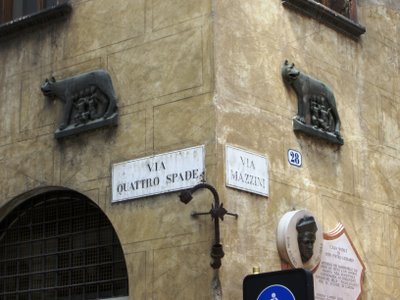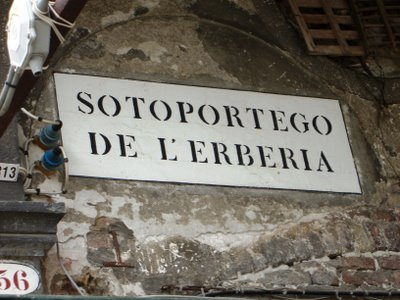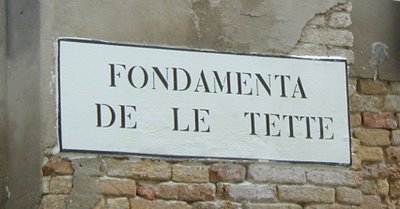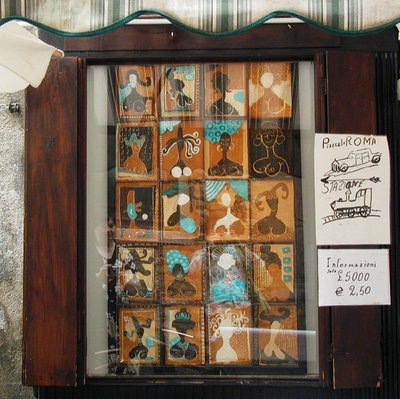On street signs, Venetian addresses...and advertising.
After the first week in Italy, I got used to the place naming systems. Common terms are via for street, piazza for square. I didn't see a single sign on a post, as we do in most countries; rather, the street names were on marble blocks set into building walls, such as this one in Milan:
Many of the street plaques list the birth and death years of the person for which the street was named, and sometimes, their profession. In Milan, a major street is sometimes called corso, as in the city's longest street, Corso Buenos Aires (where we stayed.)
Here's a pair of street signs at an interesection in Verona. Because the city was controlled by Rome, Verona has many depictions of the empire's symbol, the she-wolf suckling twins Romulus and Remus: 
Then, some cities use unique street nomenclature, as in Genoa's caruggi and vicoli, terms which come from the Ligurian dialect.
Venice, however, takes the cake when it comes to this subject.
Here, a campo is a public square; a small one is called a campiello.
A Venetian bridge is street is called ponte. A street is a calle; a particularly narrow one a calleta. However, I also saw narrow streets named rame, riva and fondamenta. The three days I spent in Venice didn't allow me enough time to observe the distinctions between them. However, here's a good primer on the mysteries of Venetian addresses.)
Still, the place names are a good indicator of the sort of activity that took place in a particular area. Near the Rialto, for example, place names around the vegetable market indicated where fish, bread and other foods were sold. Some of those words were in Spanish or Arabic, so one could also surmise the origins of the merchants who did business in those locales. (La Serenissima has always been cosmopolitan.)
Here's where a greengrocer (l'erberia, from erbe, vegetables) set up shop, in a covered walkway through a building (sotoportego):
Our Venice guide Laura gave us a very good idea of what we would have seen on those streets five hundred years ago; from Jewish moneylending tables to bakeries (panataria) and orange sellers (naranzaria), to more venal pursuits. Campiello de la Stua was one example.
Laura told us stua means "stove" in the Venetian dialect. Apprently, way back when, this little square was the site of big stoves which heated water for bathhouses. As with many bathhouses today, it was also the red light district. So you can walk through the adjoining sotoportego (a covered walkway going through a building) to the neighboring street.
Translation: "Street of Breasts." Only the word is the colloquial term for mammary glands. You get the gist. The prostitutes who lived around this fondamenta and its adjacent bridge, Ponte de le tette, advertised their wares by baring their breasts at their windows. And there were many. Laura told us there were approximately eleven thousand prostitutes in Venice in the 1500s - to a population of about two hundred thousand.
The ladies are gone now, but their memory lives on. This painting was in an art gallery on Fondamenta de le tette.
Gillian Coldsnow